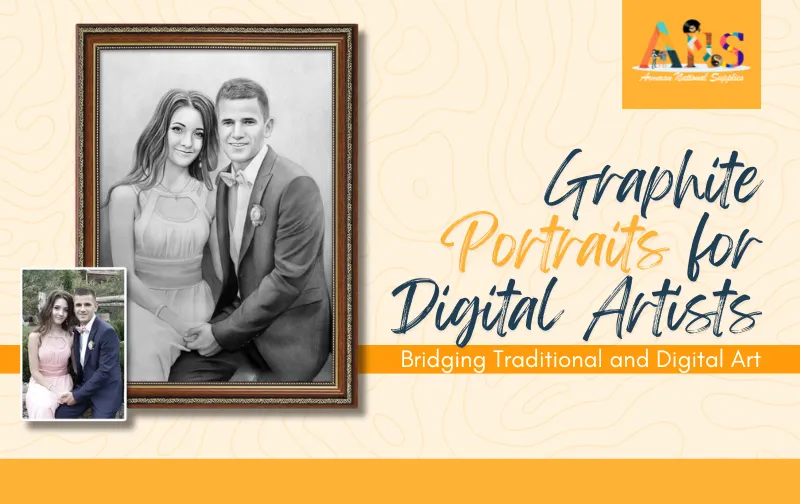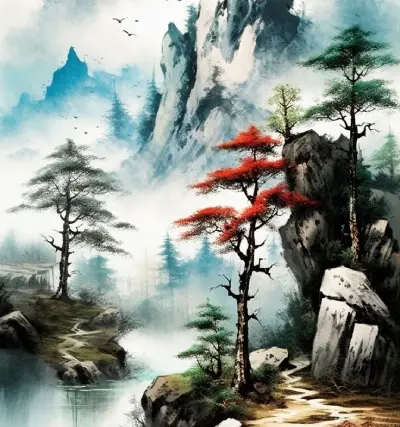LET'S REVIVE YOUR WALL
- Home
- Blog Detail

Graphite Portraits for Digital Artists: Bridging Traditional and Digital Art
- February 7, 2025,
Art has continually evolved, incorporating new techniques, materials, and technologies. While digital art has revolutionized the creative world, traditional art forms like graphite portraits remain timeless. For digital artists looking to enhance their skills, integrating graphite drawing into their workflow can offer profound benefits. This article explores how graphite portraits bridge traditional and digital art, helping artists refine their craft while keeping classic artistic values alive.
The Timeless Appeal of Graphite Portraits
Graphite portrait drawing has been a cherished art form for centuries. The ability to create lifelike representations using just a pencil and paper is both a skill and a testament to an artist’s patience and attention to detail. Unlike digital tools that offer undo functions and layers, graphite demands precision and careful planning. For digital artists, learning graphite drawing fosters discipline, a stronger understanding of lighting, and a deeper appreciation for textures and tonal values.
Why Digital Artists Should Learn Graphite Drawing
1. Improved Hand-Eye Coordination
Creating graphite portraits enhances an artist’s control over line weight, shading, and detailing. This improved coordination translates seamlessly to digital mediums, making it easier to use styluses and tablets with greater precision.
2. Mastering Light and Shadow
Graphite drawing trains the eye to see subtle shifts in light and shadow, essential for realistic digital rendering. By sketching graphite portraits, artists can develop a deeper understanding of contrast and depth, making their digital work more compelling.
3. Strengthening Composition Skills
Before turning to a tablet, creating a portrait with graphite allows artists to focus on proportions, balance, and perspective without digital aids. This traditional foundation strengthens digital compositions, ensuring accuracy and artistic integrity.
Bridging Traditional and Digital Art
Many contemporary artists blend graphite portrait drawing with digital art to create unique and compelling works. This hybrid approach allows them to combine the organic feel of hand-drawn art with the flexibility of digital enhancements.
1. Scanning and Digitizing Graphite Art
Artists often scan their graphite portraits and import them into digital software for refining, coloring, or texturing. This technique maintains the authenticity of hand-drawn lines while benefiting from digital tools.
2. Creating Graphite Brushes for Digital Use
Some artists develop custom digital brushes that mimic graphite textures. By understanding traditional graphite strokes, artists can replicate them digitally, maintaining a handmade feel in their digital portraits.
3. Mixing Media for Unique Effects
A growing trend involves starting with a graphite sketch and adding digital enhancements, such as color overlays, lighting effects, or subtle animations. This method results in a fusion of classic and modern artistic styles.
Finding Inspiration in Graphite Portraits
For those looking to explore graphite drawing, observing famous portrait art is an excellent starting point. Many renowned artists have mastered graphite as a medium, showcasing its potential in creating strikingly realistic portraits. Whether studying historical portraiture or contemporary works, artists can gain valuable insights into technique, form, and emotional expression.
Where to Get Quality Graphite Art Supplies
To create stunning graphite portraits, using high-quality materials is essential. Armaan National Supplies offers a variety of tools for graphite drawing, from premium pencils to textured paper. Investing in quality supplies enhances the drawing experience and improves the final outcome.
The Future of Graphite and Digital Portraits
The fusion of graphite portrait drawing and digital techniques is shaping the future of art. As technology advances, the ability to combine traditional hand-drawn textures with digital versatility continues to grow. Digital artists who embrace graphite drawing enrich their skill set, making their work more dynamic and versatile.
Whether you’re a seasoned digital artist or a beginner, exploring graphite portraits can elevate your artistry, offering a deeper connection to both traditional and modern creative practices. By bridging the gap between these two worlds, artists can craft unique and impactful portraits that honor the best of both artistic realms.

